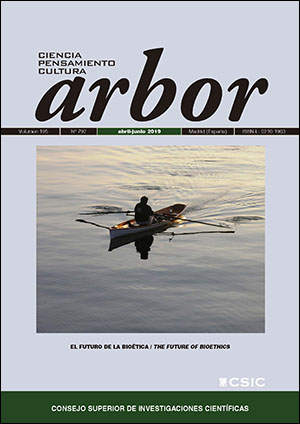The epistemological status of bioethics
DOI:
https://doi.org/10.3989/arbor.2019.792n2001Keywords:
Determinism, complexity, systemic approach, holism, ethics of technology, interdisciplinarityAbstract
Bioethics, rather than a well-defined science, seems to more closely resemble a “field” of issues and problems that has been steadily expanding since the 70s. In the beginning, it essentially focused on medicine and biotechnology; but today includes other topics as well, such as animal care and environmental protection, health policies and bio-law. The recent and extremely significant progress in medical technology has produced several new moral problems that are not covered by traditional rules and general ethics. It is, however, possible, and even necessary, to take decisions regarding these new problems, and here resides the novelty and most valuable contribution of bioethics. The novelty also derives from the remarkable complexity of the more typical bioethical debates. For these reasons, bioethics could be presented as a paradigm of what ethics must constitute in the context of a technological civilization. It is a discipline that looks for a meeting point between technology and moral conscience. Given these fundamental characteristics, it is possible to sketch a special epistemological status for bioethics: this discipline adopts an interdisciplinary method based on a systemic approach as well as on the ability to cope with the phenomena of complexity. Thus, bioethics acquires a holistic point of view that allows for a connection between the simplest and most complex levels. Finally, we will show how bioethics takes advantage of the doctrinal and cultural differences brought about in our time by globalization.
Downloads
References
Agazzi, E. (1992). Il bene, il male e la scienza. Milano: Rusconi.
Bernard, C. (1865). Introduction à l'étude de la médecine expérimentale. Paris: J. B. Baillière et fils.
Bertalanffy, L. von (1968). General System theory: Foundations, Development, Applications. New York: Braziller.
Ellul, J. (1977). Le système technicien, Paris: Calman-Levy
Jahr, F. (1927). Bio-Ethik. Eine Umschau über die ethischen Beziehungen des Menschen zu Tier und Pflanze. Kosmos. Handweiser für Naturfreunde, 24 (1), pp. 2-4.
Lamarck, J.-B. (1802). Hydrogeologie. Paris: Museum d'histoire naturelle.
Marcos, A. (2013). Ciencia y acción. Una filosofía práctica de la ciencia. México: Fondo de Cultura Económica.
Mori, M. (2002). Bioetica. 10 temi per capire e discutere. Milán: Mondadori.
Mumford, L. (1967). The Myth of the Machine (first vol.). New York: Harcourt Brace.
Poincaré, H. (1890). Sur le problème des trois corps et les équations de la dynamique. Acta Mathematica, 13 (1), pp. A3-A270.
Potter, R. (1971). Bioethics: Bridge to the Future. New Jersey: Prentice Hall
Rahner, K. (2001). Verantwortung der Theologie: Im Dialog mit Naturwissenschaften und Gesellschaftstheorie. Freiburg i.Br.: Herder
Treviranus, G. R. (1802). Biologie oder Philosophie der lebenden Natur für Naturforscher und Aerzte. Göttingen: Johan Friedrich Röwer. https://doi.org/10.5962/bhl.title.10546
Weber, M. (1992). Politik als Beruf (Vortragsmitschrift mit Nachwort von Ralf Dahrendorf). Stuttgart: Reclam. https://doi.org/10.3790/978-3-428-07724-3
Published
How to Cite
Issue
Section
License
Copyright (c) 2019 Consejo Superior de Investigaciones Científicas (CSIC)

This work is licensed under a Creative Commons Attribution 4.0 International License.
© CSIC. Manuscripts published in both the printed and online versions of this Journal are the property of Consejo Superior de Investigaciones Científicas, and quoting this source is a requirement for any partial or full reproduction.
All contents of this electronic edition, except where otherwise noted, are distributed under a “Creative Commons Attribution 4.0 International” (CC BY 4.0) License. You may read the basic information and the legal text of the license. The indication of the CC BY 4.0 License must be expressly stated in this way when necessary.
Self-archiving in repositories, personal webpages or similar, of any version other than the published by the Editor, is not allowed.














